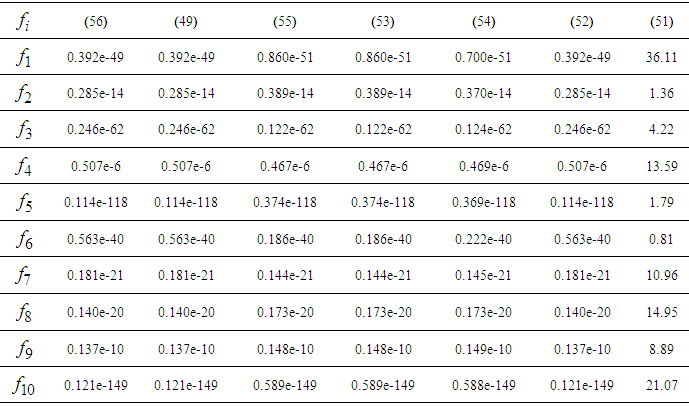-
Paper Information
- Paper Submission
-
Journal Information
- About This Journal
- Editorial Board
- Current Issue
- Archive
- Author Guidelines
- Contact Us
American Journal of Computational and Applied Mathematics
p-ISSN: 2165-8935 e-ISSN: 2165-8943
2015; 5(2): 33-41
doi:10.5923/j.ajcam.20150502.02
New Twelfth Order Iterative Methods for Finding Multiple Roots of Nonlinear Equations
R. Thukral
Padé Research Centre, 39 Deanswood Hill, Leeds, West Yorkshire, LS17 5JS, England
Correspondence to: R. Thukral, Padé Research Centre, 39 Deanswood Hill, Leeds, West Yorkshire, LS17 5JS, England.
| Email: |  |
Copyright © 2015 Scientific & Academic Publishing. All Rights Reserved.
The aims of this paper are, firstly, to present four new twelfth order iterative methods for solving nonlinear equations and secondly, to introduce new formulas for approximating the multiplicity of the iterative method. It is proved that these methods have the convergence order of twelve requiring six function evaluations per iteration. Numerical comparisons are included to demonstrate exceptional convergence speed of the proposed methods.
Keywords: Modified Newton-type method, Root-finding, Nonlinear equations, Multiple roots, Order of convergence, Efficiency index
Cite this paper: R. Thukral, New Twelfth Order Iterative Methods for Finding Multiple Roots of Nonlinear Equations, American Journal of Computational and Applied Mathematics , Vol. 5 No. 2, 2015, pp. 33-41. doi: 10.5923/j.ajcam.20150502.02.
Article Outline
1. Introduction
- Finding the root of nonlinear equations is one of important problem in science and engineering [1-28]. In this paper, we present four new multipoint higher-order iterative methods to find multiple roots of the nonlinear equation
 where
where  for an open interval I is a scalar function. The multipoint root-solvers is of great practical importance since it overcomes theoretical limits of one-point methods concerning the convergence order and computational efficiency. In recent years, many modifications of the Newton-type methods for simple roots have been proposed and analysed [13] and little work has been done on multiple roots. Therefore, the prime motive of this study is to develop a new class of multi-step methods for finding multiple roots of nonlinear equations of a higher than the existing iterative methods. In order to construct the new twelfth order method for finding multiple roots we use the well-established fourth order method given in [15, 16, 17, 20]. The purpose of this paper is to show further development of the ninth order methods and introduce new formulas for approximating the multiplicity of the iterative methods. This paper is actually a continuation of the previous study [23]. The extension of this investigation is based on the improvement of the ninth order method. In addition, the new iterative methods have a better efficiency index than the eight to ten convergence order methods [10, 23]. Hence, the proposed twelfth order methods are significantly better when compared with these established methods.The structure of this paper is as follows. Some basic definitions relevant to the present work are presented in the section 2. In section 3 the new multi-point methods are defined and proved. In section 4 the new formulas for approximating the multiplicity of the iterative methods are described. In section 5, two well-established methods are stated, it will demonstrate the effectiveness of the new twelfth order iterative methods. Finally, in section 6, numerical comparisons are made to demonstrate the performance of the presented methods.
for an open interval I is a scalar function. The multipoint root-solvers is of great practical importance since it overcomes theoretical limits of one-point methods concerning the convergence order and computational efficiency. In recent years, many modifications of the Newton-type methods for simple roots have been proposed and analysed [13] and little work has been done on multiple roots. Therefore, the prime motive of this study is to develop a new class of multi-step methods for finding multiple roots of nonlinear equations of a higher than the existing iterative methods. In order to construct the new twelfth order method for finding multiple roots we use the well-established fourth order method given in [15, 16, 17, 20]. The purpose of this paper is to show further development of the ninth order methods and introduce new formulas for approximating the multiplicity of the iterative methods. This paper is actually a continuation of the previous study [23]. The extension of this investigation is based on the improvement of the ninth order method. In addition, the new iterative methods have a better efficiency index than the eight to ten convergence order methods [10, 23]. Hence, the proposed twelfth order methods are significantly better when compared with these established methods.The structure of this paper is as follows. Some basic definitions relevant to the present work are presented in the section 2. In section 3 the new multi-point methods are defined and proved. In section 4 the new formulas for approximating the multiplicity of the iterative methods are described. In section 5, two well-established methods are stated, it will demonstrate the effectiveness of the new twelfth order iterative methods. Finally, in section 6, numerical comparisons are made to demonstrate the performance of the presented methods.2. Preliminaries
- In order to establish the order of convergence of the new twelfth order methods, we state some definitions:Definition 1 Let
 be a real-valued function with a root
be a real-valued function with a root  and let
and let  be a sequence of real numbers that converge towards
be a sequence of real numbers that converge towards  . The order of convergence p is given by
. The order of convergence p is given by | (1) |
 and
and  is the asymptotic error constant [6, 13, 27]. Definition 2 Let
is the asymptotic error constant [6, 13, 27]. Definition 2 Let  be the error in the kth iteration, then the relation
be the error in the kth iteration, then the relation | (2) |
 | (3) |
 and
and  are three successive iterations closer to the root
are three successive iterations closer to the root  . Then the computational order of convergence may be approximated by
. Then the computational order of convergence may be approximated by  | (4) |
 [23].
[23]. 3. Construction of the Methods and Convergence Analysis
- In this section we define new twelfth order iterative methods for finding multiple roots of a nonlinear equation. In order to construct new twelfth order methods, we use well known fourth order iterative methods, presented by Thukral, Sharma et al., Shengguo et al. and Soleymani et al., [15, 16, 17, 20].
3.1. Method 1
- It is well established that the first two step is the Thukral fourth order method [20] and the new third step is in the form of the Osada third order method [12]. Consequently, we obtain a new twelfth order method based on these two well-established method. The new scheme is given as
 | (5) |
 | (6) |
 | (7) |
 ,
,  is the initial guess and provided that the denominator of (7) is not equal to zero. Theorem 1 Let
is the initial guess and provided that the denominator of (7) is not equal to zero. Theorem 1 Let  be a multiple zero of a sufficiently differentiable function
be a multiple zero of a sufficiently differentiable function  for an open interval I with multiplicity m, which includes
for an open interval I with multiplicity m, which includes  as an initial guess of
as an initial guess of  . Then the iterative method defined by scheme (7) has twelfth order convergence.ProofLet
. Then the iterative method defined by scheme (7) has twelfth order convergence.ProofLet  be a multiple root of multiplicity m of a sufficiently differentiable function
be a multiple root of multiplicity m of a sufficiently differentiable function and
and  We denote the errors given by each step as
We denote the errors given by each step as 
 and
and  Using the Taylor series expansion of
Using the Taylor series expansion of  about
about  , we have
, we have | (8) |
 | (9) |
 | (10) |
 | (11) |
 and
and  | (12) |
 | (13) |
 about
about  and simplifying, yields
and simplifying, yields | (14) |
 | (15) |
 | (16) |
 | (17) |
 | (18) |
 | (19) |
 | (20) |
 about
about  , we have
, we have | (21) |
 | (22) |
 | (23) |
 | (24) |
 | (25) |
3.2. Method 2
- Another twelfth order iterative method is constructed by using a fourth order method presented by Shengguo et al. [15]. As before the first two steps is the Shengguo et al. method and third step is in the form of Osada third order method. The new twelfth-order iterative method is given as,
 | (26) |
 | (27) |
 | (28) |
 be a multiple zero of a sufficiently differentiable function
be a multiple zero of a sufficiently differentiable function  for an open interval I with multiplicity m, which includes
for an open interval I with multiplicity m, which includes  as an initial guess of
as an initial guess of  . Then the iterative method defined by scheme (28) has twelfth order convergence.ProofUsing appropriate expressions in the proof of the theorem 1 and substituting them into (28), we obtain the asymptotic error constant
. Then the iterative method defined by scheme (28) has twelfth order convergence.ProofUsing appropriate expressions in the proof of the theorem 1 and substituting them into (28), we obtain the asymptotic error constant | (29) |
 | (30) |
 | (31) |
3.3. Method 3
- The third twelfth order iterative method is based on the Sharma et al. fourth order method presented in [17]. Here also, the first two steps is the Sharma et al. method and third step is in the form of Osada third order method. The new twelfth order iterative method is given as,
 | (32) |
 | (33) |
 | (34) |
 | (35) |
 | (36) |
 be a multiple zero of a sufficiently differentiable function
be a multiple zero of a sufficiently differentiable function  for an open interval I with multiplicity m, which includes
for an open interval I with multiplicity m, which includes  as an initial guess of
as an initial guess of  . Then the iterative method defined by scheme (34) has twelfth order convergence.ProofUsing appropriate expressions in the proof of the theorem 1 and substituting them into (34), we obtain the asymptotic error constant
. Then the iterative method defined by scheme (34) has twelfth order convergence.ProofUsing appropriate expressions in the proof of the theorem 1 and substituting them into (34), we obtain the asymptotic error constant | (37) |
 | (38) |
 | (39) |
3.4. Method 4
- The fourth twelfth order iterative method is based on the Soleymani et al. fourth order method presented in [16]. Here also, the first two steps is the Soleymani et al. method and third step is in the form of Osada third order method. The new twelfth order iterative method is given as,
 | (40) |
 | (41) |
 | (42) |
 | (43) |
 | (44) |
 be a multiple zero of a sufficiently differentiable function
be a multiple zero of a sufficiently differentiable function  for an open interval I with multiplicity m, which includes
for an open interval I with multiplicity m, which includes  as an initial guess of
as an initial guess of  . Then the iterative method defined by scheme (42) has twelfth order convergence.ProofUsing appropriate expressions in the proof of the theorem 1 and substituting them into (42), we obtain the asymptotic error constant
. Then the iterative method defined by scheme (42) has twelfth order convergence.ProofUsing appropriate expressions in the proof of the theorem 1 and substituting them into (42), we obtain the asymptotic error constant | (45) |
 | (46) |
 | (47) |
4. New Formulas for Approximating the Multiplicity
- In this section, we derive some new formulas to approximate the multiplicity m of the method. In [26] Thukral presented a new formula for approximating the multiplicity m as
 | (48) |
 | (49) |
 | (50) |
 and
and  are three successive iterations closer to the root
are three successive iterations closer to the root  . Then the computational order of convergence may be approximated by the following;
. Then the computational order of convergence may be approximated by the following; | (51) |
 | (52) |
 | (53) |
 | (54) |
 | (55) |
 | (56) |
 | (57) |
 | (58) |
5. The Established Methods
- For the purpose of comparison, two iterative methods presented in [10, 23] are considered. Since these methods are well established, the essential formulas are used to calculate the approximate solution of the given nonlinear equations and thus compare the effectiveness of the new twelfth order method. The first of the method is in fact an eighth order method presented in [23] and is expressed as
 | (59) |
 | (60) |
 | (61) |
 | (62) |
 | (63) |
 | (64) |
6. Numerical Results
- In this section, we shall present the numerical results obtained by employing the iterative methods (7), (28), (34), (42), (61) and (64) to solve some nonlinear equations with known multiplicity m. To demonstrate the performance of the new higher order iterative methods, we use ten particular nonlinear equations. We shall determine the consistency and stability of results by examining the convergence of the new iterative methods. The findings are generalised by illustrating the effectiveness of the higher order methods for determining the multiple root of a nonlinear equation. Consequently, we give estimates of the approximate solution produced by the methods considered and list the errors obtained by each of the methods. The numerical computations listed in the tables were performed on an algebraic system called Maple. In fact, the errors displayed are of absolute value and insignificant approximations by the various methods have been omitted in the following tables.The new twelfth order method requires six function evaluations and has the order of convergence twelve. To determine the efficiency index of the new methods, we shall use the definition 3. Hence, the efficiency index of the new methods given by (7), (28), (34), and (42) is
 whereas the efficiency index of the eighth and tenth order methods (61) and (64) is given by
whereas the efficiency index of the eighth and tenth order methods (61) and (64) is given by  and
and  respectively. We can see that the efficiency index of the new twelfth order method has better efficiency index than the eighth and tenth order method. The test functions with known multiplicities m and their exact root
respectively. We can see that the efficiency index of the new twelfth order method has better efficiency index than the eighth and tenth order method. The test functions with known multiplicities m and their exact root  are displayed in table 1. The difference between the root
are displayed in table 1. The difference between the root  and the approximation
and the approximation  for test functions with initial guess
for test functions with initial guess  are displayed in table 2. Table 2 shows the absolute errors obtained by each of iterative methods described, we see that the new twelfth order methods are producing better results than the established methods. Furthermore, the computational order of convergence (COC) are displayed in table 3. From the table 3, we observe that the COC perfectly coincides with the theoretical result. In addition, the difference between the multiplicity m and the approximation
are displayed in table 2. Table 2 shows the absolute errors obtained by each of iterative methods described, we see that the new twelfth order methods are producing better results than the established methods. Furthermore, the computational order of convergence (COC) are displayed in table 3. From the table 3, we observe that the COC perfectly coincides with the theoretical result. In addition, the difference between the multiplicity m and the approximation  with initial guess
with initial guess  are displayed in table 4. In table 4 we observe that there is no significant difference between the Lagouanelle formula (48) and the recently introduced formulas (52)-(56), whereas the Traub’s method (51) is performing poorly. In fact,
are displayed in table 4. In table 4 we observe that there is no significant difference between the Lagouanelle formula (48) and the recently introduced formulas (52)-(56), whereas the Traub’s method (51) is performing poorly. In fact,  is calculated by using the same total number of function evaluations (TNFE) for all methods, which is after three iterations.
is calculated by using the same total number of function evaluations (TNFE) for all methods, which is after three iterations.
|
|
|
|
7. Conclusions
- In this paper, four new twelfth order iterative methods for solving nonlinear equations with multiple roots have been introduced. Convergence analysis proves that the new methods preserve their order of convergence. Simply combining the two well-established methods, we have achieved a twelfth order of convergence. The prime motive of presenting these new methods was to establish a higher order of convergence method than the existing methods [1-28]. The effectiveness of the new twelfth order methods is examined by showing the accuracy of the multiple roots of several nonlinear equations. After an extensive experimentation, it can be concluded that the convergence of the tested multipoint methods of the twelfth order is remarkably fast. The main purpose of demonstrating the new methods for different types of nonlinear equations was purely to illustrate the accuracy of the approximate solution, the stability of the convergence, the consistency of the results and to determine the efficiency of the new iterative methods. We have shown numerically, and verified, that the new iterative methods converge to the order twelfth. Empirically, we have found, in many cases that the new formulas for approximating the multiplicity m are performing better than the established methods. Finally, we have constructed new higher order iterative methods, but unfortunately these new methods are not of optimal order, hence further investigation is essential.
 Abstract
Abstract Reference
Reference Full-Text PDF
Full-Text PDF Full-text HTML
Full-text HTML


